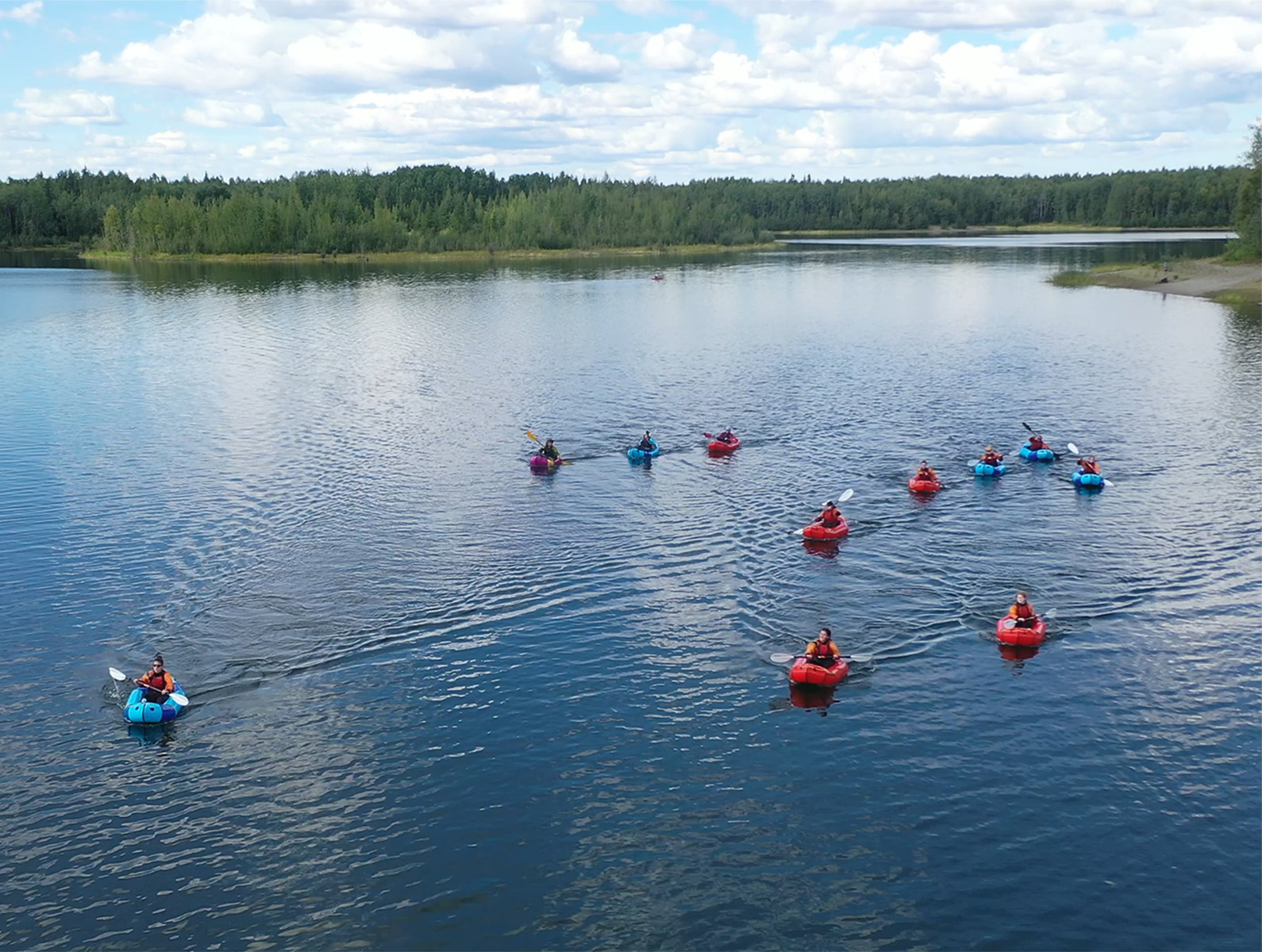High schoolers experience a summer of science
Tom Moran
907-474-5581
Sept. 28, 2021

Members of the 2021 Girls on Water expedition stop for a selfie.
Earlier this summer, 18 high school-aged É«ĘÓƵĎÂÔŘ girls piled into kayaks and packrafts and emerged with both new ecological knowledge and more confidence in themselves.
ThatÉ«ĘÓƵĎÂÔŘ™s the idea behind Girls in the Water and Girls in the Forest, two experiential learning programs that held successful wilderness expeditions in summer 2021. In July, nine 16- and 17-year-old girl-identified youths from across the state took part in Girls on Water, a week-plus scientific kayak expedition in Kachemak Bay. Then in August, nine Girls in the Forest packrafted the Chena River and learned about fire science along the way.
É«ĘÓƵĎÂÔŘśThe participants just did such an awesome job going with the flow,É«ĘÓƵĎÂÔŘť said Girls on Water lead instructor Lauren Sutton, a doctoral student at the University of É«ĘÓƵĎÂÔŘ Fairbanks. É«ĘÓƵĎÂÔŘśThis was such a fun, fun group that was super inquisitive, and I think they inspired all of us instructors every day.É«ĘÓƵĎÂÔŘť
Girls on Water
As kayak guide Laura Jackson noted, the Girls on Water participants dove right into their expedition, literally and figuratively. É«ĘÓƵĎÂÔŘśThese girls were incredible, most of them coming into this program having had no kayak experience, and jumping in boats and then flipping them right back over on day two,É«ĘÓƵĎÂÔŘť she said, describing a kayak drill.

Girls on Water participants study marine life.
The group kayaked from their base at Kasitsna Bay É«ĘÓƵĎÂÔŘ” across Kachemak Bay from Homer É«ĘÓƵĎÂÔŘ” to the head of Tutka Bay and back, camping for multiple nights at both Arch and Isthmus beaches. When they werenÉ«ĘÓƵĎÂÔŘ™t paddling on the roughly 40-mile round trip route, the students had art and science lessons and spent a great deal of time gathering scientific data. É«ĘÓƵĎÂÔŘśWe did a lot of different ecological surveys in the intertidal, learning how to (sample using) quadrats, and making different observations in the intertidal zone, looking at the different plants and animals that live there,É«ĘÓƵĎÂÔŘť explained instructor Steffi OÉ«ĘÓƵĎÂÔŘ™Daly, also a UAF Ph.D. student.
At expeditionÉ«ĘÓƵĎÂÔŘ™s end, the participants put together three science fair-style poster presentations of their findings. Topics included the impacts of changing salinity on blue mussels, of water salinity on diversity in the food web and of tidal height on barnacle size and quantity. The groups then recorded the presentations to later display online.
OÉ«ĘÓƵĎÂÔŘ™Daly called the quality of the presentations É«ĘÓƵĎÂÔŘśamazing,É«ĘÓƵĎÂÔŘť given the short time period the students had to prepare them. And Sutton noted that they were created without access to the internet. É«ĘÓƵĎÂÔŘśAll of the background information, all of the conclusions that they came up with were from each participant being a critical thinker," she said, "which is one of the most important things I think you can do as a scientist, is rely on the knowledge that youÉ«ĘÓƵĎÂÔŘ™ve gained and how it can apply to what youÉ«ĘÓƵĎÂÔŘ™re looking at.É«ĘÓƵĎÂÔŘť
Girls in the Forest
The Girls in the Forest expedition was also based around boats, but these participants had their minds in the trees. The nine students who explored the Chena River State Recreation Area east of Fairbanks in August looked at the impacts of forest fires.

Girls in the Forest instructor Anna Talucci demonstrates tree coring.
É«ĘÓƵĎÂÔŘśWe learned about boreal forest ecology in Interior É«ĘÓƵĎÂÔŘ and how fire plays a really important role in those forest ecosystems, and we learned about the surface vegetation, underneath the surface and whatÉ«ĘÓƵĎÂÔŘ™s up in the trees,É«ĘÓƵĎÂÔŘť explained lead instructor Klara Maisch.
Participants learned packraft skills at Chena Lakes Recreation Area in North Pole before floating sections of the upper Chena River and hiking the Angel Rocks and Mastadon Creek trails. They learned about both art and field science, and visited the sites of both the 2004 Tors Fire and the 2019 Nugget Creek Fire to establish transects and collect data. Halfway through the trip, the weather turned from idyllic to sopping, which offered the group an unexpected opportunity: They visited the Munson Creek Fire, which had been burning for much of the summer but was then subdued by the rain.
Like the Girls on Water, Girls in the Forest participants turned their studies into science presentations, in this case a set of online slideshows. Topics included the impacts of fire on lowbush cranberries and on moose diet, the importance of mosses in studying wildfires, and comparisons of soil layers and of rates of post-fire tree colonization.

Girls in the Forest participants and instructors practice their packrafting skills in the Chena Lake Recreation Area.
After the expedition, the students reflected on their experiences and spoke about learning to function as part of a team, to be more open-minded and to push themselves. É«ĘÓƵĎÂÔŘśI learned that when I just open up to learning something new and donÉ«ĘÓƵĎÂÔŘ™t worry about the possible outcomes, the activity can be a lot more fun,É«ĘÓƵĎÂÔŘť said one.
Both programs are funded by the É«ĘÓƵĎÂÔŘ National Science Foundation Established Program to Stimulate Competitive Research (EPSCoR) and are free of charge; applications for the 2022 expeditions open in mid-December 2021. Both are run out of the UAF International Arctic Research Center and are affiliated with the worldwide Inspiring Girls Expeditions program.
ADDITIONAL CONTACTS: Sarah Clement, UAF Inspiring Girls program coordinator, sjclement@alaska.edu, 907-474-1939; Joanna Young, UAF Inspiring Girls program director, jcyoung6@alaska.edu, 907-474-7148
MORE INFORMATION:


